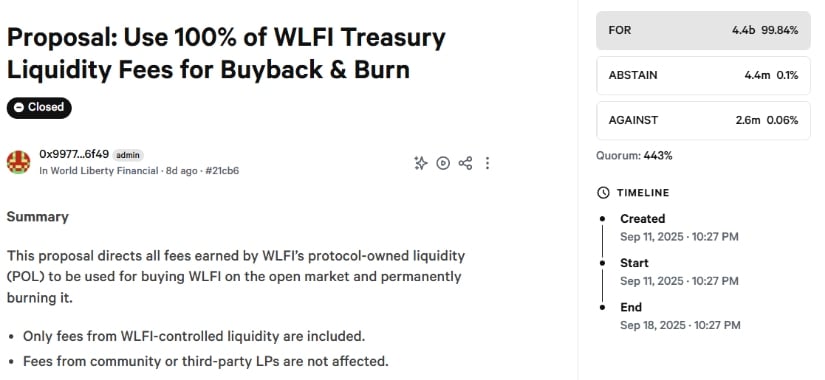Trump’s World Liberty Financial Greenlights Massive Token Buyback - Here’s What It Means for Crypto Markets
World Liberty Financial makes bold move with unprecedented token repurchase program
Market Impact Analysis
The financial giant's aggressive buyback strategy signals strong confidence in its native token's value proposition—or maybe they just realized holding actual assets beats empty promises for once. This massive repurchase initiative could trigger significant price appreciation while reducing circulating supply.
Strategic Positioning
Unlike traditional stock buybacks that often benefit executives more than investors, token repurchases in the crypto space create immediate value for all holders. The move demonstrates how decentralized finance continues to rewrite corporate finance rules—bypassing legacy systems and putting tokenholders first.
Industry Implications
This isn't just another corporate treasury maneuver—it's a statement about crypto's maturation as an asset class. When major financial institutions start treating tokens like strategic assets rather than speculative instruments, even the most cynical Wall Street veterans might need to pay attention. Though let's be real—they'll probably still call it 'funny money' while quietly allocating behind closed doors.

The September 19 vote marks a sharp turn for the project after its rocky trading debut. Only 0.06% of the community opposed the plan, showing near-universal support for the aggressive strategy.
What the Buyback Plan Actually Does
The approved strategy directs 100% of protocol-owned liquidity fees toward token buybacks. Here’s how it works:
World Liberty Financial collects trading fees from its liquidity pools on Ethereum, BNB Chain, and Solana. Instead of keeping these fees in the treasury, the platform will use every dollar to buy WLFI tokens from the open market. Those purchased tokens then get sent to a “burn address” where they disappear forever.
This creates a direct LINK between platform activity and token scarcity. More trading means more fees, which means more tokens get removed from circulation.
The governance proposal states this “removes tokens from circulation held by participants not committed to WLFI’s long-term growth and direction.” Translation: short-term sellers get bought out while long-term holders see their ownership percentage increase.
Why This Vote Happened Now
WLFI’s launch on September 1 didn’t go as planned. The token started trading around $0.331 but crashed 40% within three days. Early investors, including controversial influencer Andrew Tate, lost significant money. Tate alone lost $67,000 on his position.

Source: vote.worldlibertyfinancial.com
The project tried damage control on September 2 by burning 47 million tokens – about 0.19% of the supply. But this emergency burn failed to stop the price slide.
The new buyback strategy represents a more systematic approach. Rather than one-time burns, the platform commits to ongoing token removal tied to actual revenue.
World Liberty Financial raised concerns about participants “not committed to long-term growth.” The buyback mechanism essentially forces these sellers out by purchasing their tokens and removing them permanently.
Trump Family Stakes and Profits
Despite the token’s poor performance, the Trump family has profited substantially. Reports indicate their collective crypto wealth increased by $1.3 billion in the weeks around the token launch.
The family controls significant WLFI holdings through various entities. Donald TRUMP serves as “chief crypto advocate” while his sons Eric and Donald Jr. hold “Web3 ambassador” titles. Even Barron Trump gets listed as the project’s “DeFi visionary.”
However, recent analysis suggests the Trump family may be reducing their exposure. Forbes reported a nearly 20% reduction in their World Liberty Financial stake since late 2024, coinciding with increased regulatory scrutiny.
Market Impact and Strategic Moves
World Liberty Financial has been making strategic investments beyond its own token. The platform recently purchased $10 million in Ethereum along with $1 million each in AAVE and chainlink tokens. These purchases caused both assets to surge 30% in early trading.
The project also announced plans for a strategic crypto reserve, positioning itself alongside Trump’s broader cryptocurrency advocacy. This includes support for a potential national Bitcoin reserve.
Justin Sun, founder of Tron, emerged as a major investor with at least $75 million in WLFI tokens. His involvement adds legitimacy but also raises questions about the project’s true decentralization.
Technical Details and Transparency
The buyback program operates across multiple blockchains but maintains centralized execution. The WLFI team manually handles transactions while providing on-chain proof for verification.
All buyback and burn activities will be publicly visible on blockchain explorers. This transparency allows independent verification of the program’s effectiveness.
The proposal considered alternatives like splitting fees between treasury operations and burns. Community feedback strongly favored the full burn model, prioritizing measurable supply reduction over operational flexibility.
Future expansion could include other protocol revenue sources beyond liquidity fees, though specific details remain unclear.
The Bottom Line
World Liberty Financial’s 99.8% approval rate sends a clear message: token holders want aggressive action on supply reduction. Whether this strategy can overcome the project’s initial stumbles depends on consistent execution and growing protocol revenues.
The Trump connection brings both opportunity and risk. Political backing could drive adoption, but regulatory scrutiny continues mounting. For now, WLFI holders bet that

